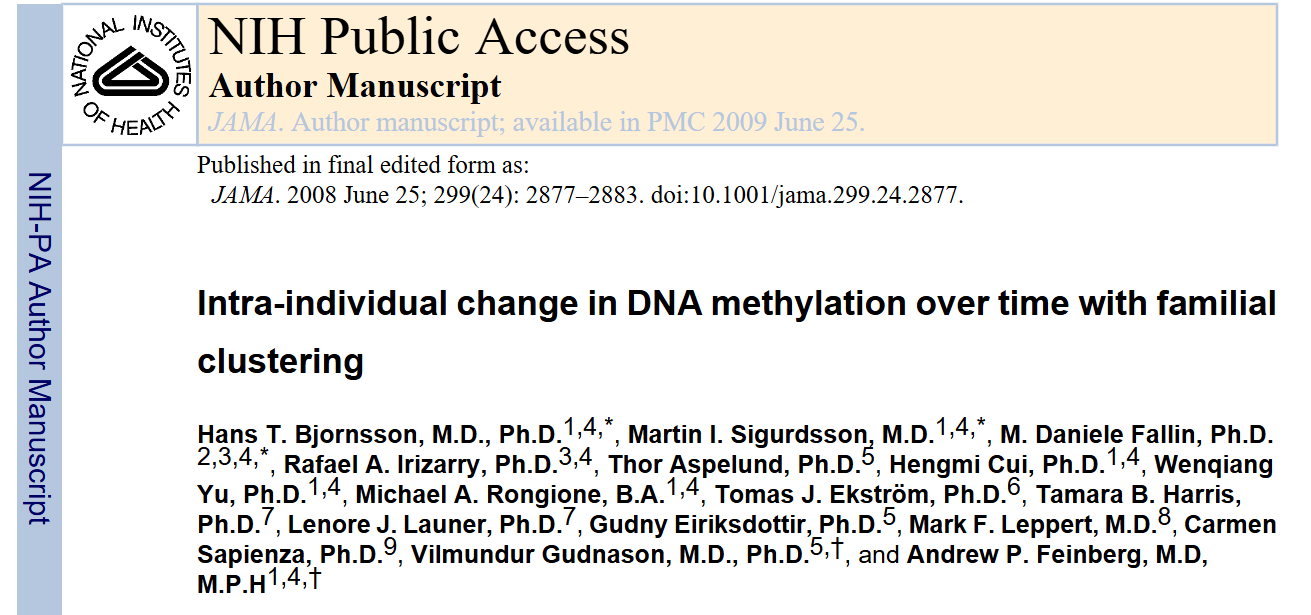In the exploration of life sciences, epigenetics has always been a key field for decoding the mysteries of diseases. It has always exuded a mysterious and charming charm, attracting countless scientific researchers to continue exploring. The research results that shine in top journals contain profound insights into epigenetics and methylation mechanisms, like a bright light in the long river of academia, illuminating our way forward. Let us review the classic papers published in top journals such as JAMA and Nature, sort out the context of academic development, appreciate the charm of classic papers, and feel the pioneering spirit of cutting-edge scientists in the field of disciplines.
A study published in JAMA (impact factor 157.335) in 2008, through long-term tracking of human groups, revealed for the first time the dynamic changes of DNA methylation in individuals and its family aggregation characteristics, providing a new perspective for understanding the occurrence of complex diseases such as cancer and aging. This study not only overturned the traditional understanding of the scientific community that "methylation maps are stable throughout life", but also opened up a new research paradigm of "dynamic epigenomics". This article will take you to review this classic study and explore the deep mechanism of epigenetic regulation.

Tribute to the classics
Bjornsson, H. T., et al. (2008). Intra-individual change in DNA methylation over time with familial clustering. JAMA, 299(24), 2877-2883. doi:10.1001/jama.299.24.2877

I. Temporal heterogeneity of methylation: "epigenetic clock" within individuals
The traditional view is that DNA methylation, as a "stable marker" of the genome, is mainly established during embryonic development and only undergoes limited changes in adulthood. However, this study consisting of a double cohort in Iceland and Utah found that the methylation level of an individual's whole genome fluctuated significantly over time: in the Icelandic cohort (average follow-up of 11 years), 29% of the individuals had a methylation change of more than 10%, of which 8.1% had a change of more than 20%. This fluctuation is not random noise - the study confirmed that methylation changes are active biological processes by excluding interfering factors such as inflammatory markers and differences in cell composition, and is closely related to the individual's physiological state or pathological process.
More noteworthy is that methylation fluctuations have clear functional tendencies. In the typical case of family 21, all five members showed significant methylation loss of immune regulatory genes (such as IL10, SYK) and imprinted genes (such as IGF2/H19). This abnormality is not only associated with familial autoimmune tendency, but also suggests that epigenetic drift may become an early driver of disease by affecting the immune system and embryonic development programs.
II. Family aggregation: genetic basis of epigenetic stability
The study of the Utah family cohort (average follow-up of 16 years) revealed another key feature of methylation dynamics - family aggregation. Through the analysis of 48 three-generation families, the study found that the methylation change pattern was highly consistent among family members, and the heritability estimate was as high as h²=0.99 (P<0.0001). Even if the extremely abnormal families were excluded, the methylation correlation of the remaining families was still significant (h²=0.743), indicating that epigenetic stability is dominated by genetic factors.
At the mechanism level, the abnormal transmission of imprinted genes has become a key clue. For example, the loss of methylation of the IGF2 gene occurs synchronously in family members. This disorder of parent-specific imprinting may be transmitted across generations through epimutations in germ cells or early embryos. This discovery challenges the traditional theory that "genetic information is transmitted only through DNA sequences" and provides a new dimension for risk assessment of familial diseases - epigenetic markers may act as "non-coding genetic information" and affect disease susceptibility without mutations in DNA sequences.
III. Technology and methods: paradigm shift from group average to individual tracking
The breakthrough conclusions of this study benefit from methodological innovation:
1. Accurate quantification of LUMA technology: The improved luminometric methylation assay (LUMA) achieves high-precision measurement of genome-wide methylation levels with an error rate strictly controlled within 2% by detecting the HpaII/MspI enzyme cutting ratio. This technology achieves reliable tracking of methylation dynamics in longitudinal studies for the first time through standard curve correction and DNA degradation control.
2. Interdisciplinary integrated design: The study combines epidemiology (dynamic monitoring of the Icelandic population), genetic family science (multi-generational family tracking in Utah) and molecular biology (Illumina methylation chip) to construct a complete chain of evidence of "phenomenon observation - genetic verification - mechanism analysis". For example, by analyzing 1505 CpG sites of 807 genes, the study found that the methylation of immune regulatory genes (such as AIM2, CSF3R) and imprinted genes was abnormally enriched, providing direct evidence for the epigenetic-immune interaction mechanism.
IV. Clinical revelation: the transformation path from static markers to dynamic intervention
1. The time window for disease warning is shifted forward
Traditional methylation detection based on population averages is prone to miss individual risks, and this study suggests that the rate of methylation change (such as annual drift percentage) may be a more sensitive warning indicator. , This methylation level that changes over time can be used as an early signal for diseases such as cancer. At present, Epiprobe and other institutions are developing multi-cancer early screening technology based on this, monitoring methylation dynamics through blood samples, and achieving "ultra-early warning".
2. Subversive revelation of research paradigm
① Individual dynamic monitoring replaces group average: Traditional cross-sectional studies are difficult to capture the individual heterogeneity of methylation, and this study proves that longitudinal tracking is crucial to identifying disease risks. In the future, it is necessary to establish a "methylation dynamic archive" and integrate multi-omics data with machine learning to build a personalized prediction model.
② Clinical significance of transgenerational epigenetic inheritance: Familial methylation abnormalities suggest that germ cell epimutations may be the source of some genetic diseases. This provides a theoretical basis for epigenetic safety assessment of prenatal diagnosis and assisted reproductive technology.
V. Future Outlook: The Dawn of Dynamic Epigenomics
This study is like a key that opens the "time dimension" of observing diseases-epigenetics is no longer an unchanging genomic blueprint, but a dynamic network that evolves over time. At present, the rise of single-cell methylation sequencing and spatiotemporal omics technologies is driving the depth of research from the population level to the single-cell level, and is expected to reveal the cell-specific mechanism of methylation dynamics.
For clinical practice, the ultimate goal of dynamic epigenomics is to achieve the full cycle management of "prediction-prevention-intervention": screening genetically susceptible individuals through newborn methylation maps, dynamic monitoring and early warning of disease risks in middle age, and reversing abnormal trajectories through epigenomic regulation technology before the onset of the disease. As the JAMA commented at the same time: "This study shows us that epigenetic plasticity is not only a byproduct of disease, but also an opportunity to rewrite the course of the disease." In the future, with the dual breakthroughs in technology and theory, dynamic epigenomics is expected to reshape the entire chain of medicine from disease prediction to personalized treatment.
Epiprobe and other institutions are promoting methylation testing from scientific research to clinical practice based on such research, and precision medicine is about to move from the "gene era" to the "epigenomic era". Perhaps in the near future, we can truly realize the medical ideal of "predicting and treating diseases before they occur" by interpreting the "time and space code" of DNA methylation.
Post time: May-30-2025

